JOSEPH TREVITHICK
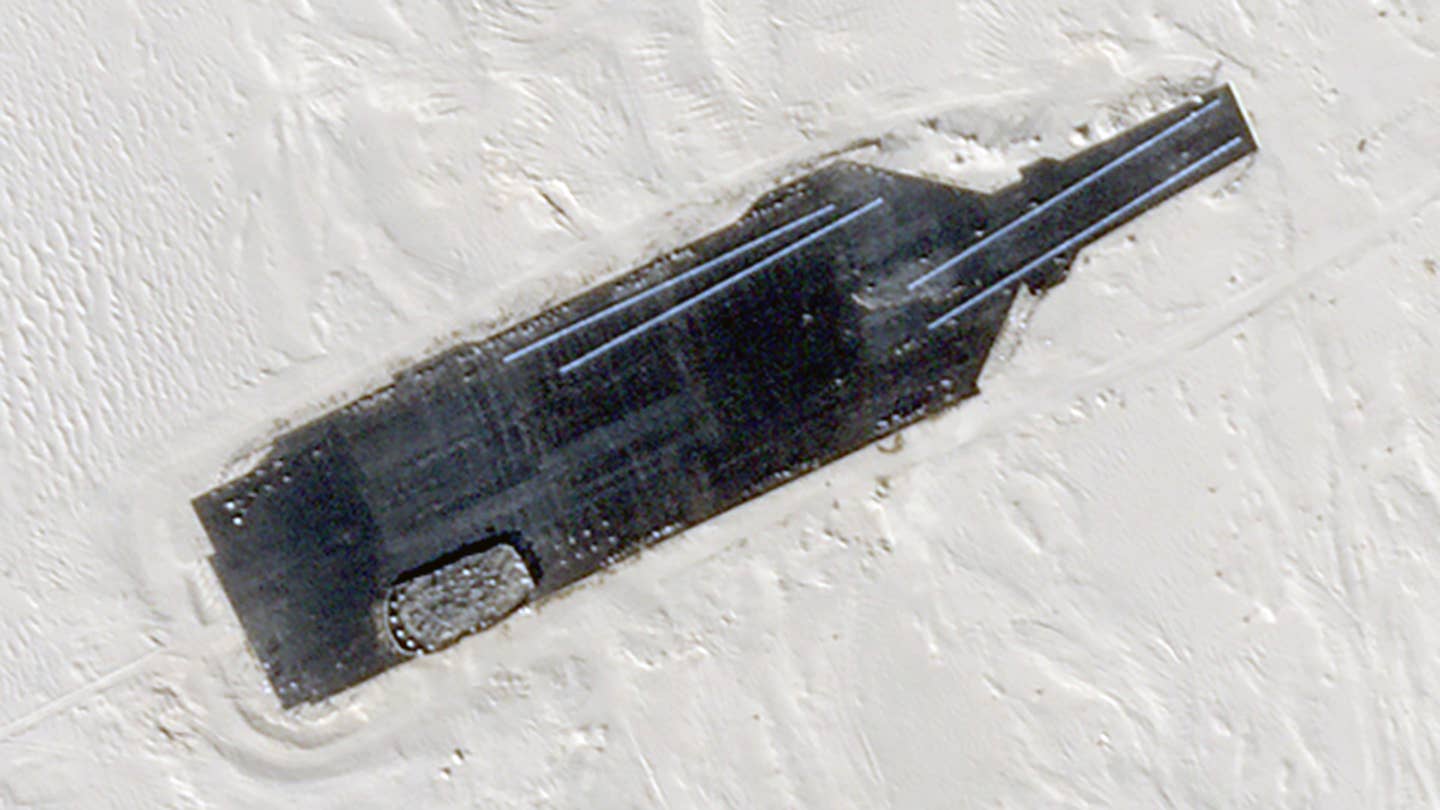
The image of the new carrier target on the range in the Taklamakan Desert in China's Xinjiang province was taken on January 1 by Planet Labs. A full-scale black-colored silhouette in the shape of the USS Gerald R. Ford, and future carriers in that class, roughly 1,085 feet long, is plainly visible. There is also a structure in the same position as Ford's island, as well as four catapult tracks marked on the 'deck' in the same places they appear on the real ship. The unique sponsons and other outcroppings, including a broader, squared-off stern, that are found on the Ford are also present in the target silhouette.
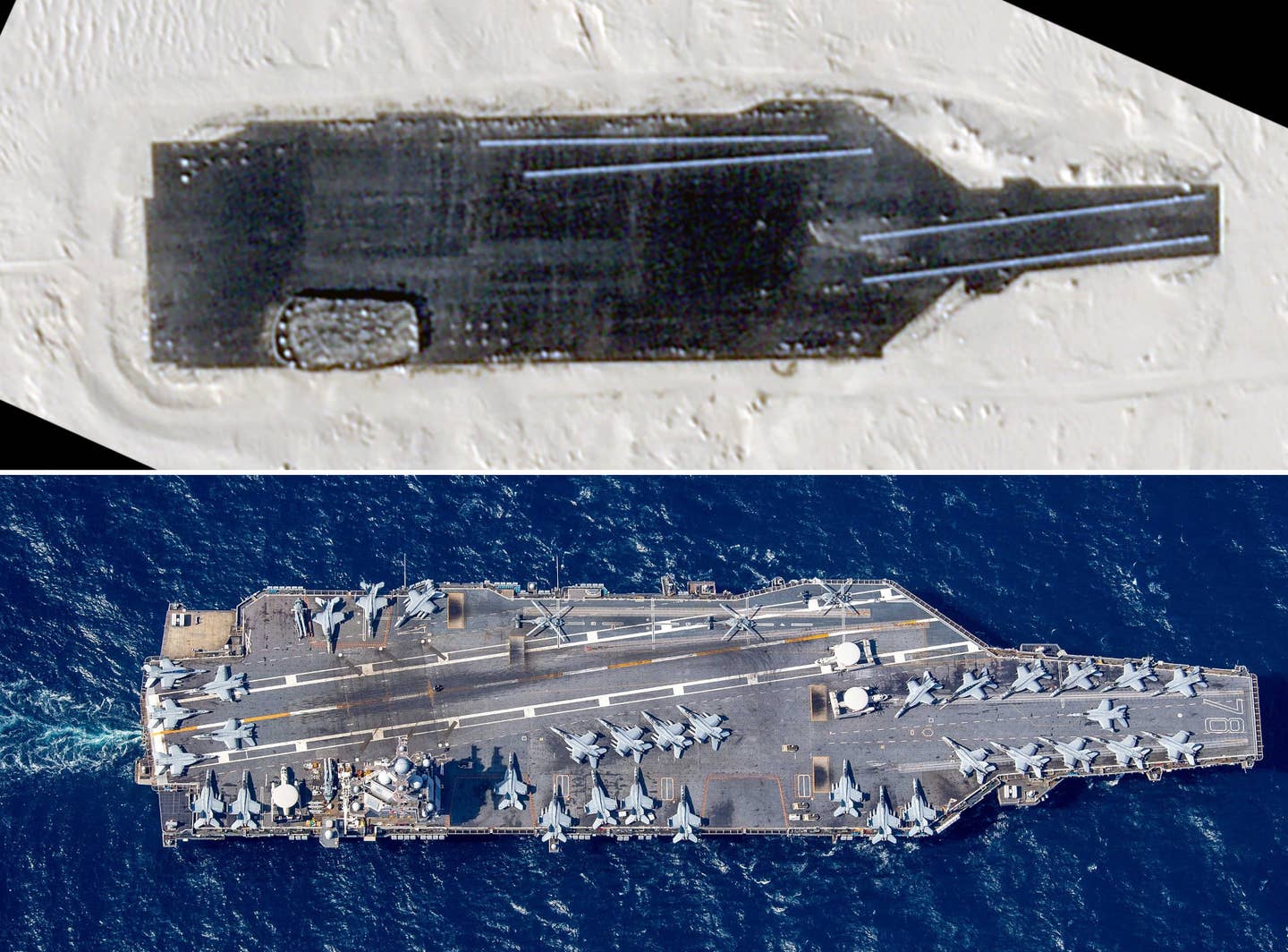 A side-by-side comparison of the new carrier target in China's Taklamakan Desert, at top, and the USS Gerald R. Ford, at bottom. PHOTO © 2024 PLANET LABS INC. ALL RIGHTS RESERVED. REPRINTED BY PERMISSION / USN
A side-by-side comparison of the new carrier target in China's Taklamakan Desert, at top, and the USS Gerald R. Ford, at bottom. PHOTO © 2024 PLANET LABS INC. ALL RIGHTS RESERVED. REPRINTED BY PERMISSION / USNVarious masts can be seen dotted around the new Ford target. Generally speaking, these masts are used as radar reflectors, which can be used in combined form to mimic the real ship's full radar signature. This, in turn, would help create a full 'phantom' carrier in the desert without the need for more extensive construction. The masts can also be used as surrogates for separate features if used in smaller groups.
Some of the masts could also be topped with antennas or other equipment for various testing purposes. Masts like this have been observed on other targets at the Taklamakan Desert range, as well as elsewhere, including at sea. In the past, The War Zone has highlighted how these features are particularly relevant to the development of new and improved radar seekers for weapons, other sensors, countermeasures, and electronic warfare systems.
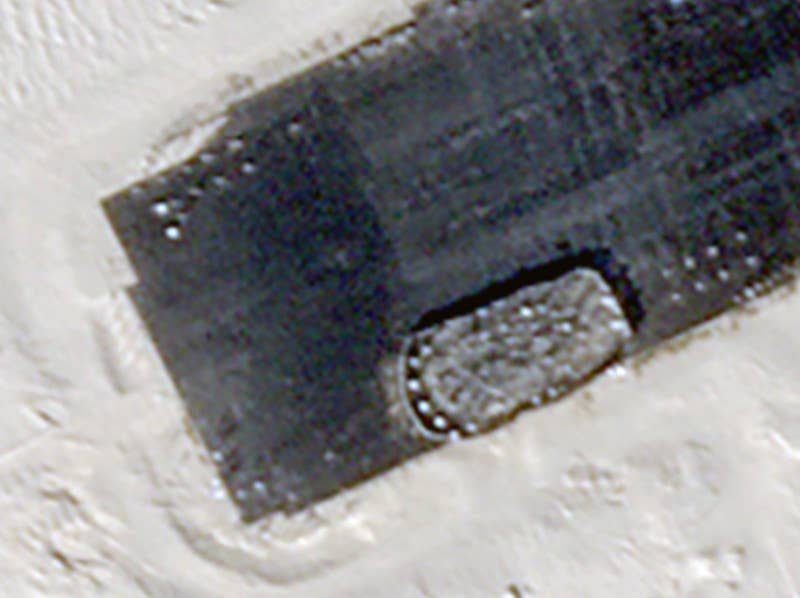 A close-up look at some of the masts that are visible on the carrier target, including on the island structure. PHOTO © 2024 PLANET LABS INC. ALL RIGHTS RESERVED. REPRINTED BY PERMISSION
A close-up look at some of the masts that are visible on the carrier target, including on the island structure. PHOTO © 2024 PLANET LABS INC. ALL RIGHTS RESERVED. REPRINTED BY PERMISSIONWork on the new carrier target began in November 2023. A review of past satellite imagery available through Planet Labs also shows that a rough outline of a carrier has been present there for some time. Several smaller aircraft carrier silhouettes have also been erected within the larger outline and subsequently removed at this site in the Taklamakan Desert on multiple occasions since 2021.
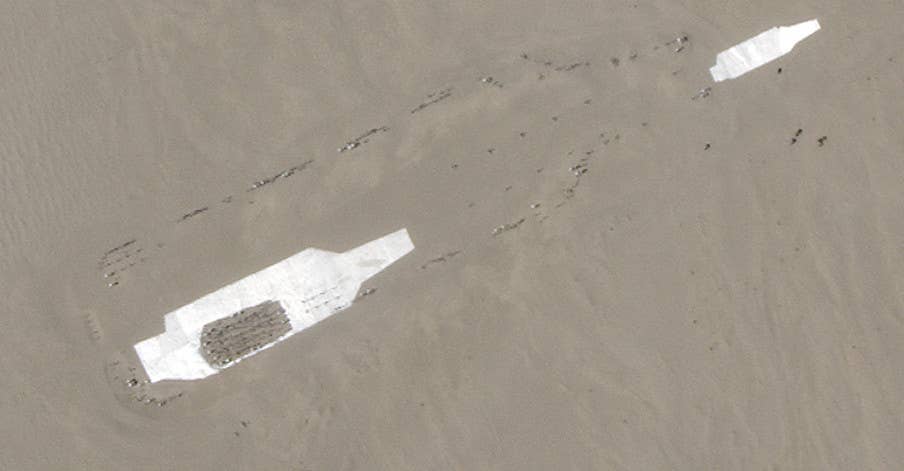 Two smaller carrier targets, as well as the outline of a larger one, can be seen in this satellite image taken on July 28, 2023. This is the same location where the larger Ford target is now present. PHOTO © 2024 PLANET LABS INC. ALL RIGHTS RESERVED. REPRINTED BY PERMISSION
Two smaller carrier targets, as well as the outline of a larger one, can be seen in this satellite image taken on July 28, 2023. This is the same location where the larger Ford target is now present. PHOTO © 2024 PLANET LABS INC. ALL RIGHTS RESERVED. REPRINTED BY PERMISSIONThe U.S. Navy took delivery of Ford in 2019 after years of technical issues and other delays. The real carrier is currently on its way back to its homeport in Norfolk, Virginia, after concluding its first fully deployment. Ford's time at sea had been extended due to the Israel-Gaza conflict.
The site of China's new Ford target is just under 2.8 miles (around 4.5 kilometers) southeast of another full-scale carrier target in the Taklamakan that garnered significant attention back in 2021. That target also has the same general dimensions as a Ford class carrier, but still lacks any significant structural additions.
Additional ship-type targets, including others meant to represent aircraft carriers and ones that look to be based around U.S. Navy Arleigh Burke class destroyers, dot the Taklamakan range. Satellite imagery shows that at least one of the destroyer targets, which had previously been just a silhouette with various radar reflector masts, has now been upgraded with additional structure features. Similarly enhanced destroyer targets have been observed on this range in the past.
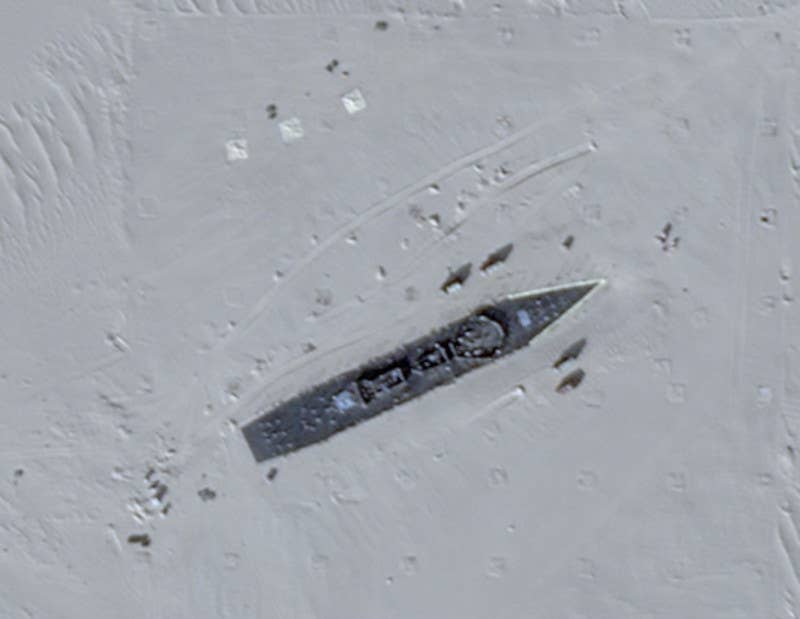 The destroyer target with structural improvements is seen in this image taken on January 1, 2024. PHOTO © 2024 PLANET LABS INC. ALL RIGHTS RESERVED. REPRINTED BY PERMISSION
The destroyer target with structural improvements is seen in this image taken on January 1, 2024. PHOTO © 2024 PLANET LABS INC. ALL RIGHTS RESERVED. REPRINTED BY PERMISSION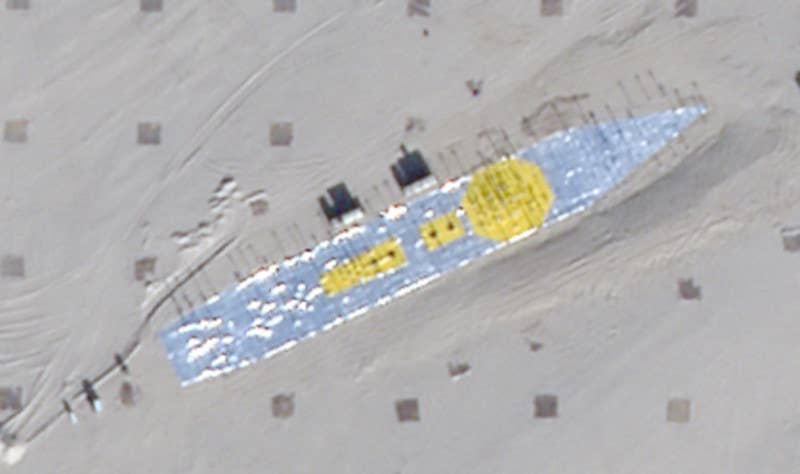 PHOTO © 2024 PLANET LABS INC. ALL RIGHTS RESERVED. REPRINTED BY PERMISSION
PHOTO © 2024 PLANET LABS INC. ALL RIGHTS RESERVED. REPRINTED BY PERMISSIONThe Taklamakan range complex is also home to at least one very large rail-based mobile ship target that you can read more about here.
All of this reflects a steady trend on the part of China's People's Liberation Army (PLA) to create higher and higher fidelity land-based naval targets to train and test against over the past few decades. The new Ford target is a world apart from the concrete rectangles and other crudely ship-shaped targets that Chinese forces used years ago. Using targets that are more representative of the real thing helps produce more accurate data during testing. They can also add additional realism during training exercises, though ranges like the one in the Taklamakan Desert are more focused on supporting research and development and test and evaluation activities.
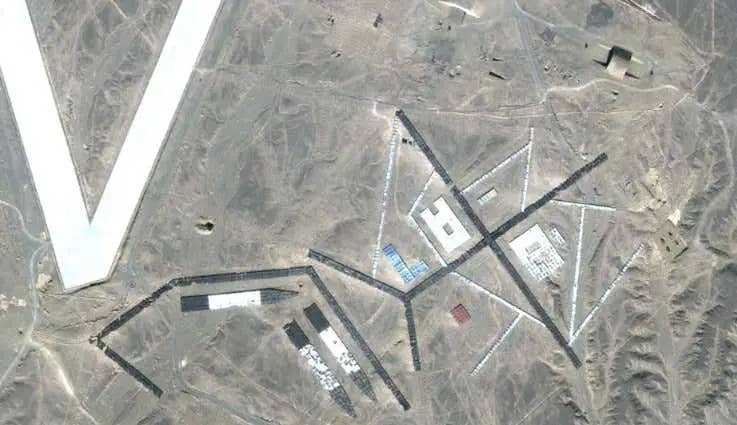 Older ship silhouette targets arrayed as part of a mock port facility at a Chinese range in the Gobi Desert. Google Earth via The Federation of American Scientists
Older ship silhouette targets arrayed as part of a mock port facility at a Chinese range in the Gobi Desert. Google Earth via The Federation of American ScientistsThe new targets also underscore the PLA's significant and ongoing investment in capabilities to neutralize U.S. Navy carriers and their associated strike groups. China's anti-access and area denial arsenal continues to expand with a particular focus on anti-ship capabilities. The country has a growing array of air-launched and land and sea-based anti-ship ballistic missiles. This is on top of increasingly advanced anti-ship cruise missiles that can be fired from more and more capable aircraft, ships, and submarines, as well as ground-based launchers. Hypersonic anti-ship cruise missiles are on the horizon for the PLA, too.
At the same time, the PLA's ability to detect and track carriers and other warships, and do so persistently further and further away from its shores, has grown in recent years. Drones are an ever-more important part of this equation for China. The PLA also has a still-expanding array of space-based surveillance and intelligence-gathering assets that increasingly rivals that of the United States. These are all capabilities that could be particularly critical to the targeting process for longer-range weapons, such as anti-ship ballistic missiles.
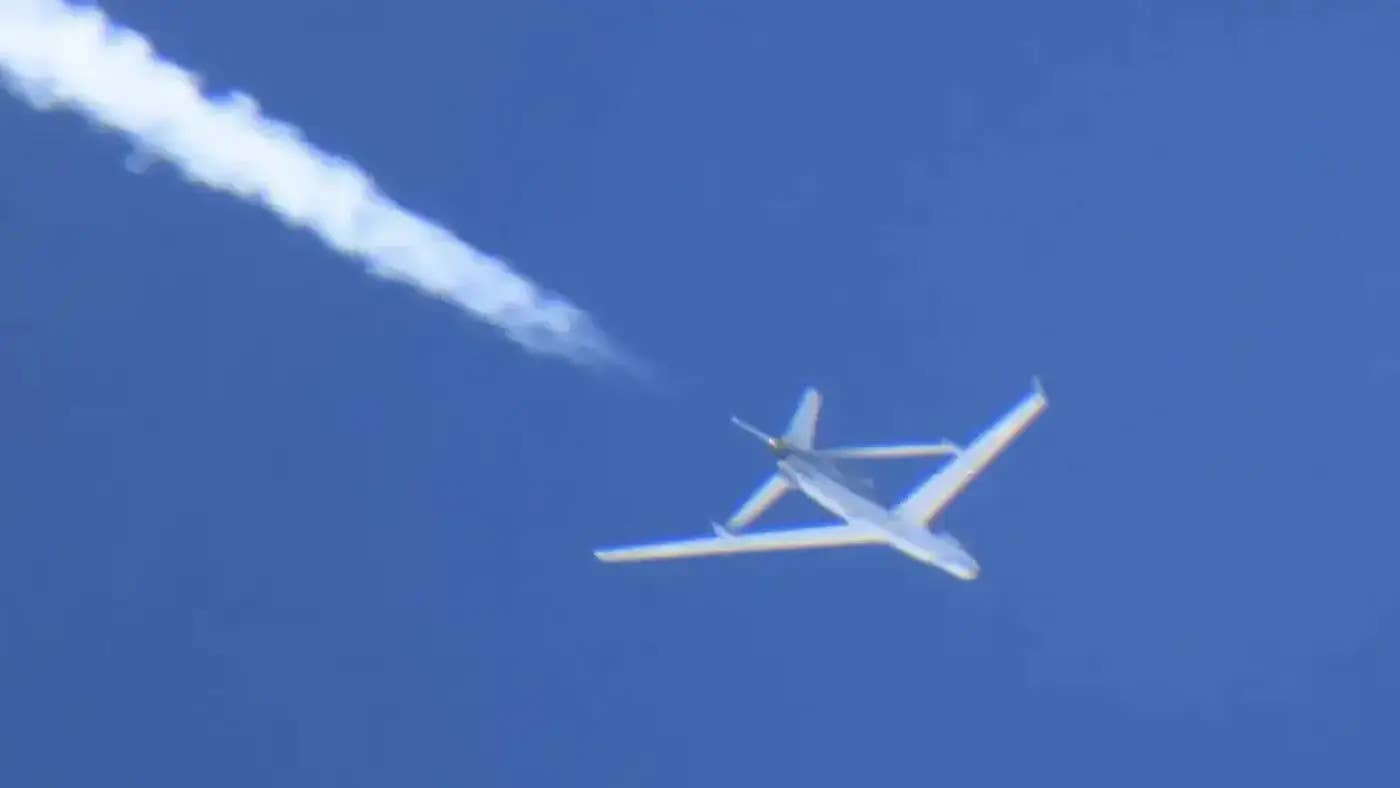 A picture of a Chinese WZ-7 surveillance drone taken from the cockpit of a Japan Air Self-Defense Force aircraft during an intercept last year. Japanese Ministry of Defense
A picture of a Chinese WZ-7 surveillance drone taken from the cockpit of a Japan Air Self-Defense Force aircraft during an intercept last year. Japanese Ministry of Defense"Recent improvements to China's space-based ISR [intelligence, surveillance, and reconnaissance] capabilities emphasize the development, procurement, and use of increasingly capable satellites with digital camera technology as well as space-based radar for all-weather, 24-hour coverage. These improvements increase China's monitoring capabilities – including observation of U.S. aircraft carriers, expeditionary strike groups, and deployed air wings," the Pentagon's most recent annual report on Chinese military capabilities, released last October, explained. "Space capabilities will enhance potential PLA military operations farther from the Chinese coast. These capabilities are being augmented with electronic reconnaissance satellites that monitor radar and radio transmissions."
All of this comes amid a now decades-long modernization push by PLA. This has produced significant results, especially in terms of its naval capabilities, something The War Zone has explored in depth previously. In addition to new anti-ship capabilities, the PLA Navy (PLAN) has been working steadily increasing the size and capabilities of its own surface warship and submarine fleets. It now moving ever closer to commissioning its third aircraft carrier, Fujian, which will be its most capable to date, as you can read more about here. There is already talk about an even more advanced nuclear-powered flattop, as well as smaller drone carriers, being in the PLAN's future.
In recent years, there has also been a surge in concerns among U.S. officials about the potential for a future high-end conflict with China in the Pacific, possibly over the status of Taiwan or another flashpoint, such as the hotly contested South China Sea. The PLA routinely harasses American ships and aircraft operating in international waters and the airspace above them across the Pacific, and has reportedly conducted mock attack runs on Navy warships in the past.
Still, even with all of these other developments, the new target in the Taklamakan Desert representing the USS Gerald R. Ford makes clear the PLA continues to put great emphasis on being able to challenge American carriers in any future conflict.
No comments:
Post a Comment